Contents
1 Introduction
A fall from height is one of the most common causes of serious injury or death in the workplace. Whilst working at height should be avoided where possible there will be occasions when it is unavoidable. Where this is the case, arrangements must be put into place to minimise the risks of falling persons or items.
Working at height includes any place above or below ground level which “if a person fell they would be likely to suffer injury” (Health and Safety Executive (HSE), 2014). Examples include, an opening in the floor, working up a ladder or where someone could fall through a fragile surface, such as a roof.
The Work at Height Regulations 2005 place duties on employers to ensure that any work carried out at height is done in a safe manner that prevents persons or equipment falling from height. The selection of access equipment, such as ladders or mobile work platforms must be carefully considered and should be suitable for the task it is designed to be used for. Access equipment includes step stools, stepladders, leaning ladders, scaffold and specialist access equipment such as ‘cherry pickers’.
2 Purpose
The purpose of the policy is to ensure that where work at height cannot be avoided:
- a suitable and sufficient risk assessment is carried out by a competent person before work is carried out
- work is properly planned, appropriately supervised and safely carried out
- the correct access equipment is selected for the type of work being carried out. Such equipment must be properly inspected and maintained. See section 5.1 for more information
- employees who are required to work at height are appropriately trained
- suitable controls are put in place to reduce the risks of working at height. These should include control measures to prevent persons not involved in the work from being struck by falling objects
3 Scope
This policy applies to all trust staff working in any part of the trust or in other organisations premises. Contractors working on behalf of the trust will also be required to comply with the standards described within the policy. They will be informed at this when they sign in before starting work and receive a site induction. A permit to work may be required for work at height. Trust staff must, in the first instance, report any concerns or non-compliance to either the Estates or Health and Safety teams.
4 Responsibilities, accountabilities and duties
4.1 Chief executive
The chief executive has specific accountability to ensure that responsibilities for health and safety are effectively assigned, accepted and managed at all levels in the trust consistent with good practice. In practice the chief executive will discharge these responsibilities by delegation to executive directors and then through the line management structure.
4.2 Managers
Where working at height may take place, all managers who are involved in supervising staff, volunteers or engaging contractors have a duty to ensure that the standards within this policy are adopted. Duties of managers include, but are not limited to:
- carrying out a risk assessment of all tasks that could be classed as working at height
- determining the most appropriate means of access or egress and involving staff, contractors and others in the decision of a safe system of work. It is important to note that working from ladders should only be used for light work undertaken for periods up to a maximum of 30 minutes
- checking that staff carrying out the task are competent to use the equipment. This includes correct assembly, appropriate fixing and securing
- ensuring that all trust staff in their area of control using such equipment are suitably trained, where appropriate. For example, scaffolds and access equipment would require documented formal training by a manufacturer, supplier or similar, whereas a stepladder or step stool could be by local demonstration by a supervisor. It is likely that work requiring the use of scaffold will be organised and managed by the Estates team
- ensuring that suitable and sufficient measures are put into place to minimise the risk of falling objects whilst work at height is being undertaken. The fitting of toe boards, netting and cordoning off zones underneath working areas should be implemented where appropriate. Guidance should be obtained from Estates
- ensuring that ladders are checked before use and undergo a regular formal inspection by a competent person. The inspection should be recorded (see appendix B)
- making staff and others aware of any fragile areas and ensuring that such areas have signage to that effect displayed
- seeking advice from either the Health and Safety team or Estates team where required about the suitability of equipment
4.3 Head of estates and facilities
Duties of the head of estates and facilities include, but are not limited to:
- ensuring that all working at height equipment which is owned by the trust is registered and recorded and subject to regular inspection and maintenance as required
- that any person, including contractors, undertaking work at height is competent to do so
- ensuring that suitable and sufficient planning and risk assessments are completed that recognise work at height can be performed safely in a number of different ways, using a wide range of work equipment
- checking that any access equipment provided by contractors is suitable for the task and of an appropriate standard
- monitoring the regular inspection of any system of access equipment in use for extended periods to ensure it remains safe. In the case of scaffolding this will be weekly
- engaging specialist contractors where heights are considered beyond the capability of untrained staff
Some of these duties are delegated to other managers in the Estates team.
4.4 Health and safety lead
Duties of the health and safety lead include, but are not limited to:
- providing advice on safe working at height
- developing a policy for working at height
Some of these duties are delegated to other members of the Health and Safety team.
4.5 Staff
Any member of staff who is required to work at height must:
- carry out a pre-use check of any equipment for visible damage or defects before use on every day when the equipment is used
- immediately take the equipment out of use if it is damaged
- immediately report any defects to their manager
- report any difficulty or danger regarding the height or the means of access to it
- make use of any equipment designed to prevent individuals or objects
- be trained to use any access equipment or work at heights system.
- use the equipment properly, in accordance with training and assist in the inspection of equipment, which is subject to a periodic maintenance regime, and check that it has been maintained before using it. Formal inspections must be recorded. For ladders the form in appendix B should be used
- report any accidents or near miss incidents using the trust’s incident reporting system
4.6 Contractors
All work undertaken by contractors must only be carried out following approval of relevant risk assessments and method statements detailing how the work will be carried out in a safe manner. Approval will usually be by an estates manager. Contractors working on behalf of the trust must:
- carry out and provide suitable risk assessments for any activities requiring work at height
- work to approved method statements with adequate controls to prevent injury to themselves or others who may be affected by their work
- provide suitable maintained access equipment to carry out the required work and check that it has been correctly installed before use and at appropriate periods thereafter
- prevent unauthorised entry to access equipment when not in use
- report all accidents or near miss incidents to their contact in the trust
5 Procedure or implementation
Managers must survey all tasks where working at height is required and ensure that:
- all work at height is properly planned and organised, refer to appendix A
- all work at height takes account of weather conditions that could endanger health and safety, for example, high winds or thunderstorm
- those involved in working at height are trained and competent
- the location where work at height is carried out is safe to work from
- equipment for work at height is appropriately inspected and maintained, refer to appendix A
- a risk assessment of the task is carried before any work is undertaken. This should include controls to minimise the risk of persons falling from height or through fragile surfaces and the risks associated with falling objects, refer to appendix C
- work at height in areas where patients are present is risk assessed and appropriate precautions taken to prevent patients gaining access to the equipment
5.1 Selecting access equipment
Only equipment that meets British and European standards and is suitable for the work should be purchased. Advice on suitable equipment can be provided by the Health and Safety team or Estates team. When purchasing new equipment consideration must be given to:
- likely ground conditions, most equipment needs a firm solid surface that is able to withstand the weight of the equipment and any load it may carry
- the expected weight of any load that might need to be carried, for example, the combined weight of the worker, materials, tools and equipment. Equipment will be marked with a maximum load capacity by the manufacturer
5.1.1 Ladders and stepladders
Ladders may be used where a risk assessment has shown that the risk is low and any work to be carried out is of short duration (usually up to a maximum of 30 minutes). Only light materials and tools should be used.
Class 1 ‘industrial’ or EN 131 ladders or stepladders must be used at work. Class 3 ladders are designed for domestic use and are not suitable for work purposes. They must not be used.
Ladders or stepladders must be:
- a suitable size or length for the intended work so that over reaching is avoided
- in good condition with no damage to any part of the ladder and no oily or slippery substances on the rungs or stiles
- tied at the top to a fixed structure, using a ladder stabiliser or anti-slip device at ground level
- used on a firm flat surface
Some stepladders have a top platform. This should only be used if the ladder has a handrail that extends above the height of the platform.
Appendix D provides further information on the trust’s standards when using ladders and stepladders.
5.1.2 Scaffolding
5.1.2.1 General access scaffold
Scaffold must only be assembled, dismantled or modified by competent persons who have received training in the type of scaffold to be installed. Less experienced scaffolders must be supervised. Scaffold must be braced and tied to a fixed structure and located on firm ground, avoiding grates or manhole covers.
Once installed scaffolding must be inspected before first use, then at least every 7 days and following any situation that might have jeopardised the integrity of the scaffold, such as high winds. Inspections must be recorded.
5.1.2.2 Tower scaffold
Persons erecting tower scaffold must be trained and competent and familiar with the type of scaffold to be installed. They should be trained by the prefabricated access suppliers’ and manufacturers’ association (PASMA).
5.1.3 Mobile access equipment
There are a variety of different types of equipment including ‘cherry pickers’ and scissor lifts that are collectively termed as mobile elevating work platforms (MEWPs). They are suitable for roof access and short duration work such as inspection or maintenance.
Equipment must be used on firm solid ground. If there is a risk of people falling from the platform, a harness with a short work restraint lanyard must be secured to a suitable manufacturer-provided anchorage point within the basket.
5.2 Special Situations
Managers and staff must take into consideration any loading that access equipment may be subject to. This may arise with items being taken on to the equipment as part of a repair job. Alternatively, it could arise with external access due to wind conditions. Where the activity for which the access is required is considered hazardous, for example ‘tree surgery’, it will be necessary to have a barrier to form an exclusion zone whilst the work is ongoing, this may include sealing access routes off. Such work must include a method statement, which details training, equipment and all safety measures to be taken.
Similarly, managers involved in minor contracts such as window cleaning must ensure that the equipment being used is suitable and working methods are safe.
6 Training implications
Training will vary from simple demonstration of a stepladder to more formal training on specialist access equipment.
All staff who use tower scaffolds, ladders and stepladders must undertake training which gives them awareness of the hazards of using the equipment and what to inspect, including pre-use visual inspection checks to ensure such equipment remains in good working order. As a minimum, all staff who use ladders or stepladders as part of their work must be made aware of the information on leaning ladders and stepladder safety leaflet jointly produced by the ladder association and HSE (opens in new window).
Where managers are unsure of the suitability of equipment, advice should be sought from either the Health and Safety team or Estates team.
7 Monitoring arrangements
7.1 Adherence to policy
- How: Safety inspections, observations, and incident reports.
- Who: Managers and Safety team.
- Reported to: Health and Safety Forum.
- Frequency: Ongoing.
7.2 Safe use of ladders by trust staff and awareness of policy
- How: Health and safety inspection.
- Who: Safety team.
- Reported to: Area manager and care group director.
- Frequency: Annually.
7.3 Contractor work at height
- How: Observation of work at height and adherence to method statements.
- Who: Estates project manager.
- Reported to: Head of estates and facilities.
- Frequency: Ongoing.
8 Equality impact assessment screening
To access the equality impact assessment for this policy, please email rdash.equalityanddiversity@nhs.net to request the document.
8.1 Privacy, dignity and respect
The NHS constitution states that all patients should feel that their privacy and dignity are respected while they are in hospital. High Quality Care for All (2008), Lord Darzi’s review of the NHS, identifies the need to organise care around the individual, “not just clinically but in terms of dignity and respect”.
As a consequence the trust is required to articulate its intent to deliver care with privacy and dignity that treats all service users with respect. Therefore, all procedural documents will be considered, if relevant, to reflect the requirement to treat everyone with privacy, dignity and respect, (when appropriate this should also include how same sex accommodation is provided).
8.1.1 How this will be met
There are no additional requirements in relation to privacy, dignity and respect.
8.2 Mental Capacity Act (2005)
Central to any aspect of care delivered to adults and young people aged 16 years or over will be the consideration of the individuals’ capacity to participate in the decision-making process. Consequently, no intervention should be carried out without either the individual’s informed consent, or the powers included in a legal framework, or by order of the court.
Therefore, the trust is required to make sure that all staff working with individuals who use our service are familiar with the provisions within the Mental Capacity Act (2005). For this reason all procedural documents will be considered, if relevant to reflect the provisions of the Mental Capacity Act (2005) to ensure that the rights of individual are protected and they are supported to make their own decisions where possible and that any decisions made on their behalf when they lack capacity are made in their best interests and least restrictive of their rights and freedoms.
8.2.1 How this will be met
All individuals involved in the implementation of this policy should do so in accordance with the guiding principles of the Mental Capacity Act (2005) (section 1).
9 Links to any associated documents
This policy should be read and implemented in association with the following trust policies:
- security policy
- Slips, trips and falls for staff and visitors, prevention and management policy
- Estates guidance, trust safety rules and guidance for contractors and sub contractors
- Management and control of contractors policy
10 References
- Health and Safety at Work etc. Act 1974.
- Management of Health and Safety at Work Regulations 1999.
- The Work at Height Regulations 2005.
- Safe Use of Ladders and Stepladders, a brief guide. LA455, Version 1, Rev 0, 07/21. Published by The Ladder Association. (Replacing HSE Guidance Document INDG455 of the same name).
- Working at height, a brief guide INDG401 (rev 2), HSE 01/14
- HSE website provides further information on working at height (opens in new window).
11 Appendices
11.1 Appendix A Planning and organising work at height
- Can work at height be avoided?
- Yes, carry out work safely from ground level
- No, identify who will carry out the task.
- Does a risk assessment and safe system of work (SSOW) already exist?
- No, complete a risk assessment and SSOW for the activity.
- Yes, can you adapt or modify it to suit your needs?
- No, complete a risk assessment and SSOW for the activity.
- Inform, instruct, supervise and train staff (use HSE guidance, staff briefings and other guidance from the Health and Safety Office.
- Monitor effectiveness of control to ensure protection of all persons that may be affected, for example, by inspections, spot checks, reviewing accidents and near miss incidents.
- Set an appropriate review date, for example, after a set period, when new technology is introduced or where the situation changes significantly or following an accident or near miss.
11.2 Appendix B Pre-use checks and detailed visual inspections
11.3 Appendix C Risk assessment form
11.4 Appendix D Working at heights ladder safety guidance
Workers familiar with ladders can become complacent of the hazards associated with working on ladders. For many years these hazards were accepted as an inevitable part of the job. However, much can be done to reduce the risks of these hazards and many well-proven and tested methods exist to control or minimise the associated risks.
The use of ladders as a means of access and as a working platform is an acceptable practice, which with appropriate safety systems in place, is acceptable to the health and safety enforcement authorities in the UK.
Failure to take appropriate precautions to control the risks involved with work at height is a contravention of the work at height regulations and other health and safety law and may result in enforcement action being taken by the health and safety executive. Such action may result in prosecution, with the potential for an unlimited fine or even a custodial sentence in the most severe circumstances.
This document sets out the trust’s minimum standard safety system for working at height on and from ladders which should ensure compliance with legal requirements, principally the work at height regulations. It applies to both in house staff and contractors.
The precautions required by the regulations will depend on a number of factors such as the duration and complexity of the work, the weather conditions etc. However in all cases the selection of precautions to reduce the risk of falling must take into account the following hierarchy:
- where possible, eliminate the need to work at height
- prevent falls by providing a fixed means of access, for example, the use of existing means of access, access scaffolding, working platforms, mobile elevating working platforms, etc.
- fall restraint-make it difficult or impossible to fall using additional equipment
- fall arrest, if a fall may occur, stop that fall as quickly and as safely as possible by use of appropriate equipment
The regulations allow for the use of ladders as a means of access and as a place of work, but only if it is reasonable to do so having regard to the nature of the work and its duration, and only when the ladder is adequately stabilised and secured.
For many tasks it will be acceptable to use ladders, and in all cases it will be reasonably practicable to use them with a fall protection system.
The fall protection system described below provides protection for persons working from ladders.
All trust staff and contractors who work at height must be trained in risk assessing and planning work at height tasks, including the use of ladders, techniques for securing ladders, ladder stabilisation devices, fall protection systems, PPE, emergency procedures and be capable of inspecting their own ladders and safety equipment.
11.4.1 Securing and stabilising a ladder
Only ladders to an appropriate industrial standard should be used. Ladders designed for domestic purposes are generally not suitable.
A ladder should be used such that the bottom of the ladder makes an angle of 75 degrees with the horizontal surface that it is resting on. This is often referred to as the “1 in 4” rule, the distance the ladder reaches up the wall should be 4 times the distance the bottom is out from the wall.
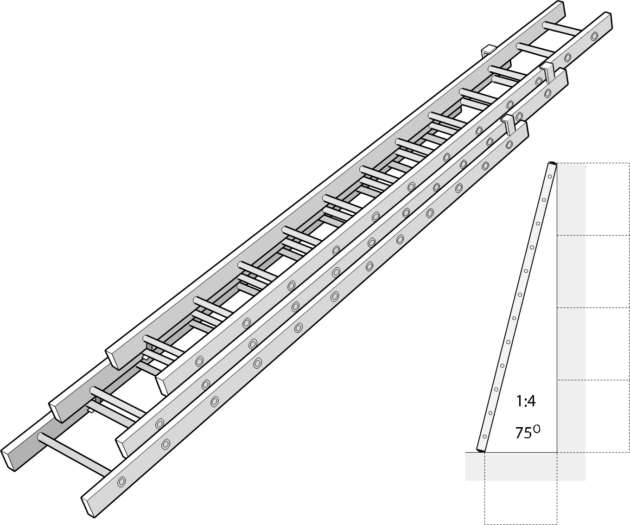
11.4.1.1 Securing the base of the ladder
It is important that a ladder is set on a good, firm surface that is as level as possible. Where the surface is firm but not level, there are devices that can be used to make the surface more level. There are a number of devices that can be fitted to the bottom of the ladder that will assist in setting the ladder at the correct angle and for securing it as its base. See the ladders 999 website (opens in new window) for more information.
11.4.1.2 Securing the top of the ladder
When a ladder is on a firm, level, stable surface with safety feet intact and a clear area around the base, precautions at the top of the ladder must be considered.
If lateral movement is going to occur and cause a fall most likely it will occur whilst at or toward the top. So, how do we make sure this doesn’t happen? Even with the perfect surface, the weight and motion of a person can cause something to go wrong (and we’re assuming they haven’t even overloaded up with tools, causing them to exceed the ladder’s limits). There are a few things that could help, the most important of which is making sure that the top of the ladder is secured every time it is used. This needs to be done by securing the top of the ladder to the structure by tying it to something sturdy with a rope or by some other means. Assuming this is done well, the ladder should not move at all. However, it is not always possible to find something to which to secure the ladder. In these situations, a ladder stabiliser or stand-off must be used. This device attaches to the top of the ladder making the area where the ladder contacts the structure much wider, and therefore much more stable.
A stabiliser or stand-off must be fitted to the top of the ladder. A common type of stand-off is the Microlite. Other stand-off devices are available and may also be suitable. These devices must be fitted before the ladder is lifted into place on the wall and must be fitted between the third and fourth rung and attached according to the manufacturer’s guidelines. The figure below illustrates the system in place.
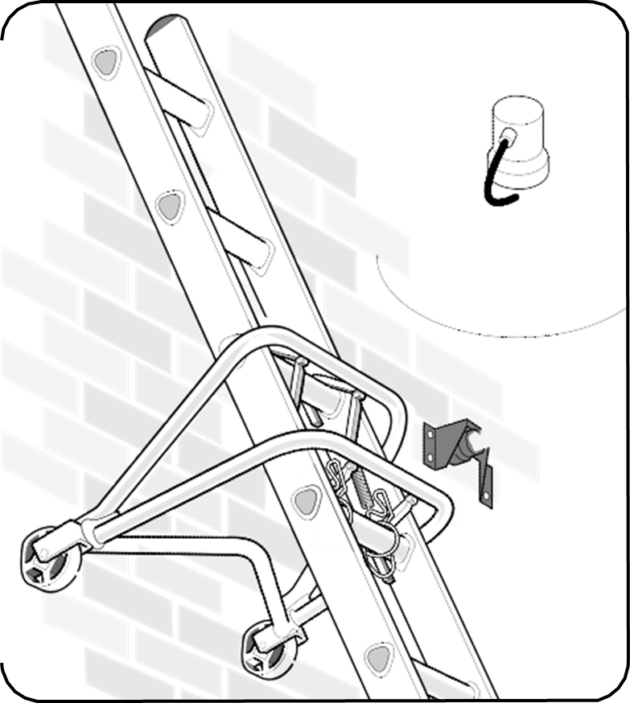
A range of other types of top stays is shown on the ladder 999 website (opens in new window).
Many ladder accidents occur as a worker at height tries to cross from a roof or other surface to a ladder for descent. The ladder can kick out, shift laterally, or the worker can simply lose their footing or balance as they try to get around the side rails. It is easy to reduce this exposure with a simple ladder extension which allows the worker to step straight through the ladder side-rails and allow for a good handhold while mounting and dismounting.
11.4.1.3 Securing the ladder at mid-point to the wall
The ladder should be secured in place by passing a ratchet strap through a rung roughly halfway up the extended length of the ladder and passing it through an eyebolt placed in a pre-drilled hole in the wall. There are a range of eyebolts, from 10mm to 20mm which can be used and all are considered to be sufficient to hold the loads imposed on a ladder during normal use for securing the ladder to a wall.
Drill 1 to 1.5m above the ground.
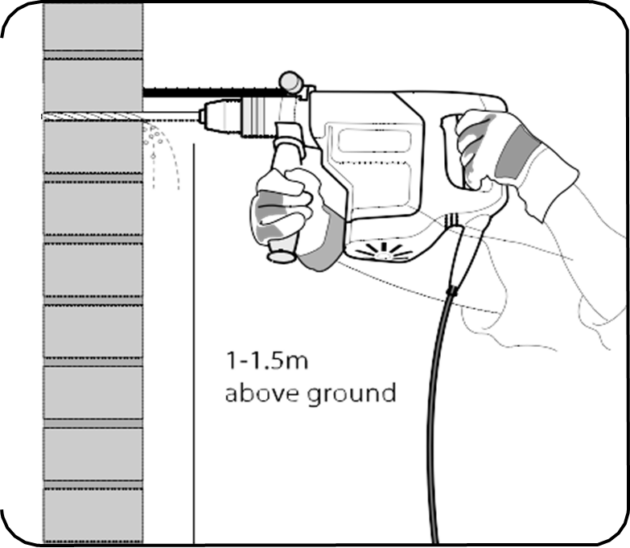
A 20mm eyebolt is considered strong enough if fitted correctly to act as an attachment point for a fall arrest rope.
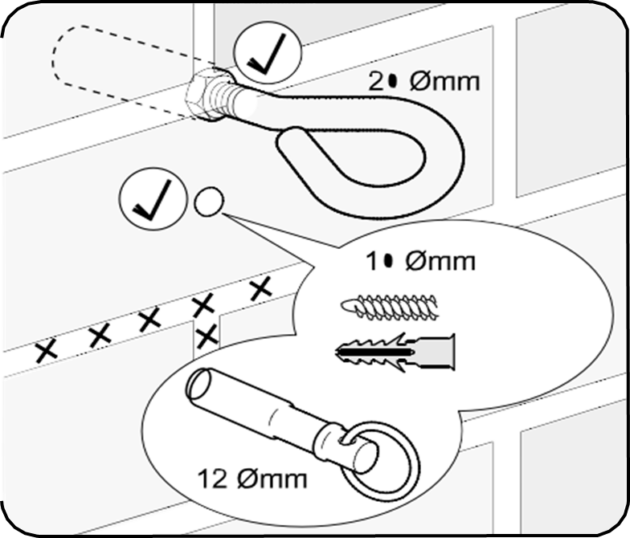
The ratchet strap should be tightened until the load on the ladder is such that the ladder will not move, some light bowing off the ladder is acceptable.
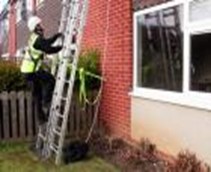
11.4.2 Fall protection
In order to protect those working a fall protection system is required.
11.4.2.1 Fall protection body harness
A semi static rope to EN1891 is the minimum standard when used as a fall arrest system. The rope should be attached to the ladder whilst it is still on the ground. The body harness should be worn, and a rope grab used whilst climbing, descending and working from the ladder. When in the working position, a lanyard should be connected to the harness D ring.
11.4.2.2 The use of ladders without fall protection devices
A ladder can be worked from without fall protection if the following conditions are true:
- the ladder can be securely fixed against slipping outwards or sideways
- the work is of short duration
- tools, equipment and material can be carried, and the task completed whilst maintaining three points of contact (for example, two feet and one hand) with the ladder at all stages on the operation
If the above criteria cannot be met, in particular if three points of contact cannot be achieved at all stages of the process, then a fall protection system is required.
Document control
- Version: 7.1.
- Unique reference number: 222.
- Approved by: Corporate policy approval group.
- Date approved: 30 January 2024.
- Name of originator or author: Health and safety lead.
- Name of responsible individual: Health, safety and security forum or executive director of nursing and allied health professions.
- Date issued: 30 January 2024.
- Review date: November 2024.
- Target audience: All managers with responsibilities derived from the policy and all staff who may be required to work at height.
Page last reviewed: January 17, 2025
Next review due: January 17, 2026
Problem with this page?
Please tell us about any problems you have found with this web page.
Report a problem